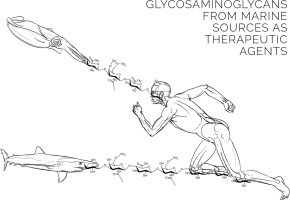Biotechnology Advances ( IF 16.0 ) Pub Date : 2017-07-21 , DOI: 10.1016/j.biotechadv.2017.07.008 Jesus Valcarcel , Ramon Novoa-Carballal , Ricardo I. Pérez-Martín , Rui L. Reis , José Antonio Vázquez

|
Glycosaminoglycans (GAGs) in marine animals are different to those of terrestrial organisms, mainly in terms of molecular weight and sulfation. The therapeutic properties of GAGs are related to their ability to interact with proteins, which is very much influenced by sulfation position and patterns. Since currently GAGs cannot be chemically synthesized, they are sourced from natural products, with high intra- but also inter-species variability, in terms of chain length, disaccharide composition and sulfation pattern. Consequently, sulfated GAGs are the most interesting molecules in the marine environment and constitute the focus of the present review. In particular, chondroitin sulfate (CS) appears as the most promising compound. CS-E chains [GlcA-GalNAc(4S,6S)] extracted from squid possess antiviral and anti-metastatic activities and seem to impart signalling properties and improve the mechanical performance of cartilage engineering constructs; Squid CS-E and octopus CS-K [GlcA(3S)-GalNAc(4S)], dermatan sulfate (DS) from sea squirts [-iK units, IdoA(3S)-GalNAc(4S)] and sea urchins [-iE units, IdoA-GalNAc(4S,6S)] and hybrids CS/DS from sharks (-B/iB [GlcA/IdoA(2S)-GalNAc(4S)], -D/iD [GlcA/IdoA(2S)-GalNAc(6S)] and –E/iE units [GlcA/IdoA-GalNAc(4S,6S)]) promote neurite outgrowth and could be valuable materials for nerve regeneration. Also displaying antiviral and anti-metastatic properties, a rare CS with fucosylated branches isolated from sea cucumbers is an anticoagulant and anti-inflammatory agent. In this same line, marine heparin extracted from shrimp and sea squirt has proven anti-inflammatory properties, with the added advantage of decreased risk of bleeding because of its low anticoagulant activity.
中文翻译:

来自海洋的糖胺聚糖作为治疗剂
海洋动物中的糖胺聚糖(GAG)与陆地生物的糖胺聚糖不同,主要在于分子量和硫酸盐化方面。GAG的治疗特性与其与蛋白质相互作用的能力有关,这很大程度上受硫酸化位置和模式的影响。由于目前无法通过化学方法合成GAG,因此它们是从天然产物中获得的,就链长,二糖组成和硫酸盐化方式而言,它们在物种内部和物种之间的变异性都很高。因此,硫酸化GAG是海洋环境中最有趣的分子,构成了本综述的重点。特别是硫酸软骨素(CS)似乎是最有前途的化合物。CS-E链[GlcA-GalNAc(4S,从鱿鱼中提取的6S)]具有抗病毒和抗转移活性,似乎赋予了信号传导特性,并改善了软骨工程结构的机械性能;鱿鱼CS-E和章鱼CS-K [GlcA(3S)-GalNAc(4S)],海鞘[-iK单位,IdoA(3S)-GalNAc(4S)]和海胆[-iE单位,IdoA-GalNAc(4S,6S)]中的硫酸皮肤素(DS)和鲨鱼的杂种CS / DS(-B / iB [GlcA / IdoA(2S)-GalNAc(4S),-D / iD [GlcA / IdoA(2S)-GalNAc(6S)]和–E / iE单位[GlcA / IdoA-GalNAc(4S,6S)])促进神经突生长,并可能是神经再生的有价值的材料。从海参中分离出的具有岩藻糖基化分支的稀有CS还具有抗病毒和抗转移特性,是一种抗凝血剂和抗炎剂。在同一生产线中,从虾和海鞘中提取的海肝素已被证明具有抗炎特性,并且由于其抗凝活性低而具有降低出血风险的优势。



























 京公网安备 11010802027423号
京公网安备 11010802027423号